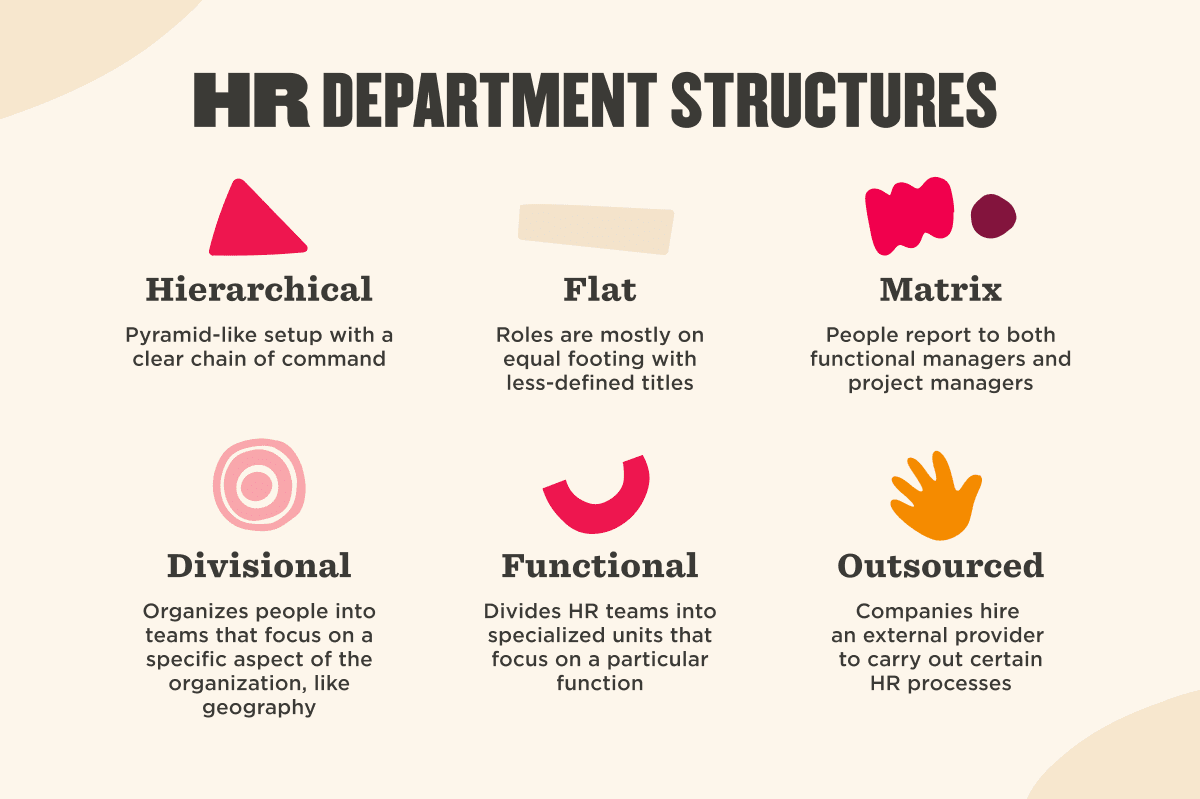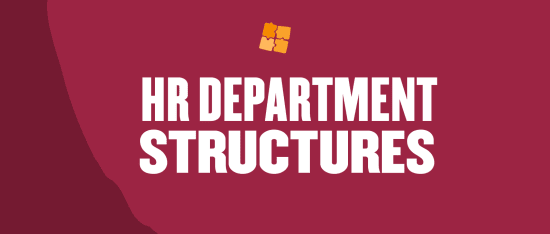HR is a cornerstone of organizational success and bears the responsibility of looking after an organization’s most valuable asset: its people. Since HR takes care of something so crucial to the success of a company, the HR department structure—and how well it functions—directly impacts the entire organization.
Every organization approaches HR differently. Smaller companies often rely on generalists to cover multiple responsibilities, while larger businesses benefit from specialized roles to handle core HR functions. These differences reflect the unique needs of each workplace and show why flexibility in structure matters.
What is an HR department?
The HR department is in charge of looking after an organization’s people. It’s the nerve center responsible for managing every aspect of a professional’s journey within the company, from recruiting and onboarding through to offboarding.
<<Ensure your HR processes are up to standard with our HR audit checklist.>>
What does an HR department do?
The role of HR goes beyond just hiring and firing. The HR department shapes the company’s culture, ensures compliance with employment laws, encourages team members’ growth, manages disputes, and implements strategic initiatives to boost people’s performance.
In fact, 80 percent of CHROs report actively partnering with their CEO on company culture and strategy, highlighting how HR has moved from administrative care to executive influence.
“You had to beg to get time before the full board in the past, but now HR chiefs are sitting in board meetings as active participants,” says Johnny C. Taylor Jr., President and CEO of the Society for Human Resource Management. This shift underscores HR’s growing strategic value and influence, making the structure and effectiveness of the HR department more critical than ever.
How is an HR department structured?
The structure of anHR department sets the framework for how the HR team is organized and operates within a company. It defines roles, responsibilities, and hierarchies to determine how HR teams collaborate and communicate.
A clear structure enhances efficiency, ensuring everyone knows their tasks and how they fit into the bigger picture. This organization helps maintain smooth workflows and effective decision-making to align HR activities with the company’s overall goals.
Centralized vs. decentralized HR structures
A centralized structure means a central location or team manages all HR functions and decisions. This setup promotes consistency and can streamline policy application, providing a uniform approach across the organization. However, it might slow response times and create a disconnect from local nuances since decisions are made from a distance.
A decentralized HR structure allows HR responsibilities to be spread across various departments or locations. This setup empowers local teams to address specific needs promptly, adapting to cultural and operational contexts. While it offers flexibility, it can lead to inconsistent policy application and challenges in maintaining a unified company culture.
Organizational benefits of an effective HR department structure
The clarity of a well-organized HR department structure boosts efficiency and aligns efforts with the organization’s goals, offering a range of benefits:
- Stronger morale and job satisfaction: A well-structured HR function ensures people feel supported, heard, and connected to the company’s mission. When roles, expectations, and communication are clear, professionals understand how their work contributes to broader goals. This clarity builds a sense of purpose, boosts morale, and strengthens job satisfaction across teams.
- More efficient processes and cost savings: An organized structure streamlines HR processes and reduces redundancies. This efficiency translates into significant cost savings, since teams can use resources wisely and complete tasks more effectively.
- Better company reputation: A well-structured HR department helps build a positive company image. When HR services are thoughtful and people-focused, they can contribute to a culture that appeals to top talent and encourages team members to stay and grow.
- Enhanced legal compliance: A structured HR department ensures that the organization stays on top of employment laws and regulations. Dedicated professionals focused on compliance help companies reduce legal risks and maintain a strong ethical foundation.
- Improved strategic alignment: When HR activities align with the company’s strategic goals, everyone moves in the same direction. This alignment ensures HR initiatives directly support the organization’s success, driving growth and innovation.
HR department roles and responsibilities
The HR department is made up of a variety of different roles, including:
- HR managers. At the helm of the HR department stands the HR manager or director, who oversees the entire operation. They develop a company’s HR strategy, establish initiatives that look after people, and align with company objectives.
- HR generalists. These are versatile professionals who handle a wide variety of HR tasks. Their responsibilities include employee relations, benefits administration, and tracking professional engagement and performance.
- Recruiters. Recruiters manage the hiring process, identifying the right people to bring into an organization. They ensure new hires meet the skill requirements of a role and fit in with the company culture.
- People data analysts. They transform raw data into actionable insights and can predict future trends, helping the HR department make effective strategic decisions.
- Compensation and benefits administrators. These administrators manage payroll, oversee benefits programs, and analyze compensation trends to help the company maintain equitable pay structures and stay competitive.
- Learning and development specialists. Learning and development specialists design training programs, identify skills gaps, and provide professional development opportunities for people.
- HRIS specialists. Experts in human resources information systems (HRIS), HRIS specialists manage the HR software and technology that contribute to effective human capital management (HCM) and smooth and efficient HR processes.
- Employee relations managers. Employee relations managers are key in nurturing positive interactions between team members and the organization. They manage conflicts, mediate disputes, and ensure a supportive workplace environment.
- Health and safety specialists. Health and safety specialists make sure the workplace is safe and complies with occupational health regulations. They develop safety policies, perform risk assessments, and promote a culture of wellbeing to protect all team members.
Common HR department structures
Here are some of the typical HR department structures, with their advantages and disadvantages:
Hierarchical
The hierarchical structure follows a pyramid-like setup with a clear chain of command—from an HR manager at the top to HR assistants at the bottom of the pyramid. A department with this clear HR hierarchy has well-defined roles where it’s evident who team members should report to.
Advantages
- Role clarity: Everyone knows their responsibilities and who to report to, reducing confusion
- Controlled decision-making: Senior leadership drives decisions to maintain consistency and align with organizational goals
- Clear reporting lines: Teams follow a clear chain of command, which supports accountability and smooth communication
Disadvantages
- Bureaucracy: The layers of management may slow down decision-making and innovation
- Limited flexibility: A rigid structure can hinder adaptability to change
- Limited collaboration and communication: Vertical communication may impede information flow between different levels
Flat
In a flat structure, roles are mostly on equal footing. Titles may be less defined, and all team members, regardless of level, contribute to decisions around HR initiatives. The flat structure nurtures a collaborative environment and promotes open communication across different HR functions within the department.
Advantages
- Greater communication: Open lines facilitate dialogue and idea-sharing among team members
- Flexibility and adaptability: The structure allows quick responses to changes and challenges
- Empowers team members: Everyone’s input is valued, building engagement and innovation
Disadvantages
- Lack of clear roles and responsibilities with the potential for conflict: The absence of defined roles can lead to confusion and disputes over responsibilities
- Overburdened managers: With fewer layers of leadership, managers may struggle to provide adequate support or oversight across a wide team
- Slower decision-making in larger teams: Consensus-driven approaches can delay action when many voices are involved, especially as teams grow
Matrix
The matrix structure combines elements of both hierarchical and flat structures. There’s less of a hierarchy, like the flat structure. However, people report to both functional managers and project managers. This reporting system promotes flexibility, collaboration, and efficient resource allocation.
Advantages
- Greater collaboration: Cross-functional teams work together, enhancing cooperation and knowledge sharing
- Better decision-making: Access to diverse perspectives improves the quality of decisions
- Improved communication: Dual reporting lines facilitate information flow across departments
Disadvantages
- Confusion over roles and responsibilities: Dual reporting can lead to ambiguity and overlapping duties
- Potential for conflict: Competing priorities may arise between functional managers and project managers and creating tension and misalignment
- Coordination challenges: Balancing multiple projects can make collaboration more challenging
Divisional
This structure organizes people into teams (or divisions) that focus on a specific aspect of the organization, such as geographical region. For example, there may be an HR director who oversees the company’s global HR operations, with managers leading autonomous human resources divisions for each region around the world.
Advantages
- Ability to address the unique needs of each division: Teams can develop custom solutions for different markets or regions
- Greater autonomy among teams: Divisions can operate independently, encouraging innovation and responsiveness
Disadvantages
- Complicated coordination of the different divisions: Ensuring alignment and consistency across divisions can be challenging
- Less collaboration due to divisions becoming isolated: Teams may work in silos, reducing synergy and shared learning
Functional
Similar to the divisional structure, the functional structure divides HR teams into specialized units that focus on a particular function such as recruitment, training, or compensation.
Advantages
- Allows for specialized expertise in each function: Teams can develop deep knowledge and skills in their areas
- Increases efficiency in each HR process: Focused efforts lead to streamlined operations
- Can improve outcomes in specific HR areas: Expertise elevates the quality of HR initiatives
Disadvantages
- Less collaboration between units: Silos can form, hindering information sharing and cooperation
- Difficult to align units with an overarching HR strategy: Ensuring that all functions support the broader company goals can be complex
Outsourced
An outsourced structure is where a company hires an external provider to carry out certain HR processes. This may be a useful option for small companies, growing organizations that need extra support, or new organizations that are still setting up their HR infrastructure.
Advantages
- Saves money: Reduces the need for a large in-house HR team, lowering overhead costs
- Access to HR expertise and greater resources: External providers offer specialized knowledge and technology
- More time to focus on long-term strategy: In-house teams can concentrate on strategic planning and development
Disadvantages
- Less control: Relying on external providers may reduce the company’s influence over HR processes
- Greater risk of data breach: Sharing sensitive information with third parties increases security concerns
- Lack of a personal touch within company culture: Outsourcing may impact the organization’s ability to maintain a cohesive and personalized employee experience

How to evaluate your HR department structure
Regularly evaluating your HR department structure and functions ensures the department runs at its best. Here are some key steps for the evaluation process:
- Identify and assess KPIs. Consider metrics that align with your organization’s goals, such as turnover rates, engagement, and operational costs. Investigate their trends over time for more accurate results.
- Conduct an HR audit and gather data. Assess your HR department’s existing policies, procedures, and practices. Assess whether the way it functions meets your company’s goals, legal requirements, and your people’s needs.
- Gather feedback. Seek and consider suggestions from HR team members, managers, and executives.
- Review employee turnover and retention: Analyze turnover and retention data to help you grasp the dynamics within your team. Spotting patterns can uncover issues related to culture, management, or compensation.
- Compare and benchmark. Compare your HR department structure to industry best practices and competitors. This will help you identify opportunities for adopting more innovative HR strategies.
- Develop an implementation plan. Based on your evaluation’s findings, consider which department structure best meets the needs of your organization and develop an implementation plan.
- Make your organization chart accessible to everyone. Ensure that your organization chart is readily available and easily accessible to all team members. This transparency builds understanding and clarity about roles and reporting lines.
- Use technology to streamline the organizational process. Leverage technology to determine and visualize HR department structures efficiently. HR software can automate data collection and provide visual representations of organizational hierarchies, simplifying complex processes.
- Update HR department structure and org chart regularly. Regular updates ensure the HR department structure and organization chart remain relevant and reflect any changes within the company. Keeping these tools current supports adaptability and continuous improvement.
HR department structure by company size
Understanding how HR departments typically operate in small businesses, mid-sized companies, and enterprise organizations can help tailor HR strategies to fit the unique demands of each size category.
These structures often appear within their respective company sizes, but there’s no one-size-fits-all model. You can design your HR setup by drawing inspiration from the different styles we’ve reviewed—centralizing analytics like larger organizations or maintaining flexible roles like smaller teams. Your goals, growth stage, and available resources will shape the best approach.
Small businesses
In small businesses, HR functions are often handled by a single individual or a small team. They wear many hats, managing everything from recruiting and onboarding to payroll and compliance. The structure is usually flat, with minimal hierarchy, which allows for quick decision-making and close interaction with business leaders.
Mid-sized companies
Mid-sized companies typically have a more defined HR structure with specialized roles. You might find dedicated recruiters, compensation specialists, and learning and development experts. While the hierarchy is still relatively flat, there’s more clarity in roles, allowing team members to focus on specific HR areas.
HR teams structure communication clearly and standardize processes to support the growing workforce efficiently.
Enterprise organizations
In large enterprises, leaders organize HR departments into distinct teams, each focused on a specific HR function. This includes talent acquisition, employee relations, data analytics, and strategic planning.
The hierarchical structure ensures clear reporting lines and consistent policy application across the organization. While this setup offers efficiency and expertise, HR leaders must coordinate closely to align activities with the company’s overall goals.
Clarify your HR department structure to build a foundation for success
An organizational chart is like a map for your company. It lays out who does what, who reports to whom, and how everyone fits into the bigger picture. Think of it as a tool that brings clarity and order, helping team members see their roles and how they contribute to the company’s success.
Understanding the different types of HR organizational structures and their pros and cons lets you shape an HR department that supports your people in reaching their goals. With this solid foundation, your HR team can truly excel in what they do best. An effective HR department helps you build a thriving organization where people feel valued and motivated.
<<Use this free org chart template to help you visualize and streamline your HR structure.>>
HR department structure FAQs
What are the core functions of HR?
HR is the backbone of any organization, handling essential tasks that keep everything running smoothly. These core functions include recruiting and onboarding, where HR finds and welcomes new team members, and compensation management, where they ensure fair and competitive pay. They may also manage learning and development initiatives, offering their people opportunities for growth.
What is the ideal size of an HR department?
The ideal size of an HR department depends on the overall company size, goals, and HR initiatives you want to put in place. Smaller companies usually need a greater HR-to-person ratio than large organizations. This is because the essential HR processes require a minimum number of HR professionals to be able to carry out their objectives effectively. However, organizations that wish to focus on particular functions of HR—such as talent management, succession planning, or learning and development—may increase the proportion of relevant HR team members.
How can an HR structure adapt to company growth?
Adapting to growth is all about flexibility. Start by expanding your HR team with specialized roles to tackle new challenges. Leveraging scalable HR tech can streamline processes and keep communication flowing.
Don’t forget to revisit your HR structure and strategies regularly, ensuring they align with the evolving goals of your organization. Embrace a mindset of continuous improvement—this keeps your HR structure agile and ready to grow alongside your company.
Recommended For Further Reading
- Human resource planning (HRP): Meaning, process, and examples
- Innovative HR initiatives: 12 inspiring examples for success in 2025
- Why HR data literacy skills drive better decision-making
- Understanding HR career paths
- HR job titles: A complete list for the new world of work
- Popular HR operating models
Should small businesses outsource their HR functions?
For small businesses, outsourcing HR functions can be a smart move. It offers access to expertise and tech without the overhead of an in-house team. This approach frees up your resources to focus on core activities while ensuring compliance and efficiency.
However, weigh factors like budget, company culture, and the need for personalized HR support. Determining the right balance for your needs will help you decide if outsourcing aligns with your long-term strategy.
What is the hierarchy of the human resource department?
The hierarchy of job titles in an HR department usually starts with the HR manager or director at the top, steering the overall strategy. Then you’ll find HR generalists handling day-to-day tasks, supported by specialists in areas like recruitment or learning and development. HR assistants or coordinators keep things running smoothly, providing crucial administrative support.


